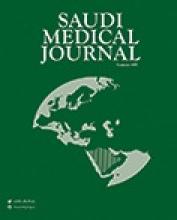Abstract
OBJECTIVE: To ascertain the role of cardiac diseases as a risk factor for stroke in a cohort of Saudi children who were evaluated in a retrospective and prospective study.
METHODS: Children with cardiac diseases were identified from within a cohort of 104 Saudi children who presented with stroke. They were seen as inpatients in the Pediatric Wards or evaluated at the Outpatient Clinics of the Division of Pediatric Neurology (DPN), and the Division of Pediatric Cardiology at King Khalid University Hospital, Riyadh, Kingdom of Saudi Arabia during the periods July 1992 to February 2001 (retrospective study) and February 2001 to March 2003 (prospective study). A comprehensive form for clinical, neuroimaging, neurophysiological and laboratory data retrieval was designed and completed for each patient. Cardiac evaluation included 12-lead ECG and serial echocardiograms. Cardiac catheterization and 24-hour ambulatory ECG (Holter) were conducted on clinical discretion.
RESULTS: Cardiac diseases were the underlying risk factor for stroke in 6 (5.8%) of the 104 children (aged one month to 12 years). The patients (4 males and 2 females) were evaluated at the DPN at a mean age of 5.3 years (range = 1-8 years; median 6.5 years). Onset of stroke was at a mean age of 34 months (range = 4 months - 8 years; median = 30 months). Five patients had stroke in association with congenital heart disease (CHD), whereas the sixth had restrictive cardiomyopathy. The identified CHD consisted of membranous ventricular septal defect in a 5-year-old boy who had moyamoya syndrome and sickle cell beta0-thalassemia, asymptomatic patent ductus arteriosus (PDA) in a 17-month-old girl, atrioventricular canal defect and PDA in an 8-year-old boy who also had Down syndrome, partial anomalous pulmonary venous drainage in a one-year-old boy, and Tetralogy of Fallot in an 8-year-old boy. The latter patient developed hemiparesis secondary to a septic embolus, which evolved into brain abscess involving the right fronto-parietal region. This was successfully managed surgically. The sixth patient was an 8 1/2-year-old girl who had hemiparesis and complex partial seizure in association with restrictive cardiomyopathy. Serial echocardiograms depicted resolution of the cardiac abnormalities within 5 years and subsequent normal findings.
CONCLUSION: Cardiac diseases, as a group, constitute a significant risk factor for stroke in Saudi children. Early diagnosis of these diseases is important to prevent further recurrences of stroke, and because some of them are potentially curable.
- Copyright: © Saudi Medical Journal
This is an open-access article distributed under the terms of the Creative Commons Attribution-Noncommercial License (CC BY-NC), which permits unrestricted use, distribution, and reproduction in any medium, provided the original work is properly cited.






